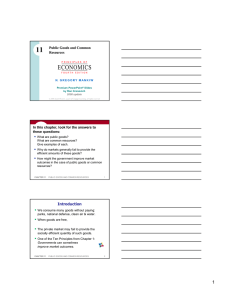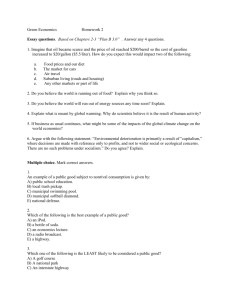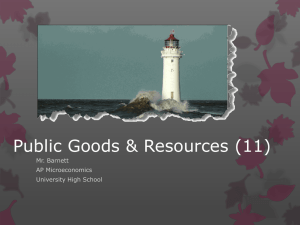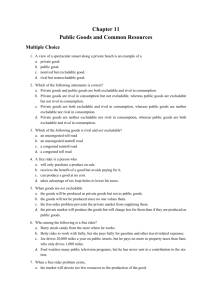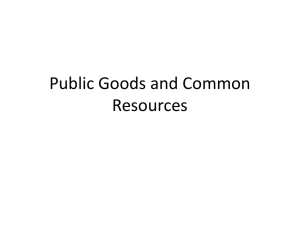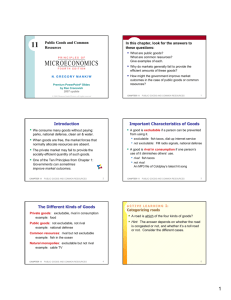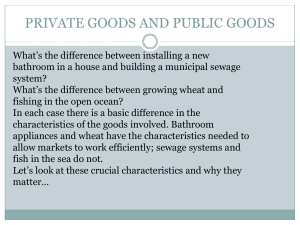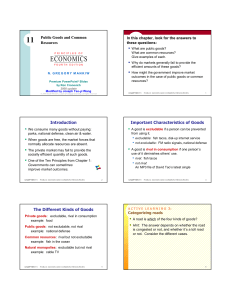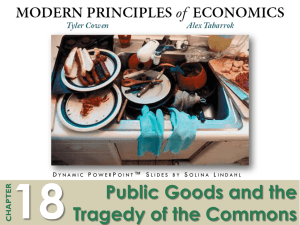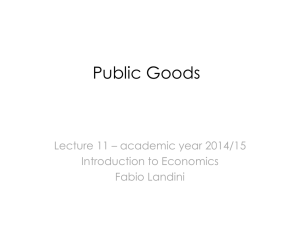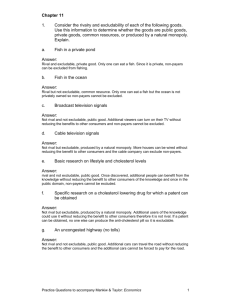Chapter 11
advertisement
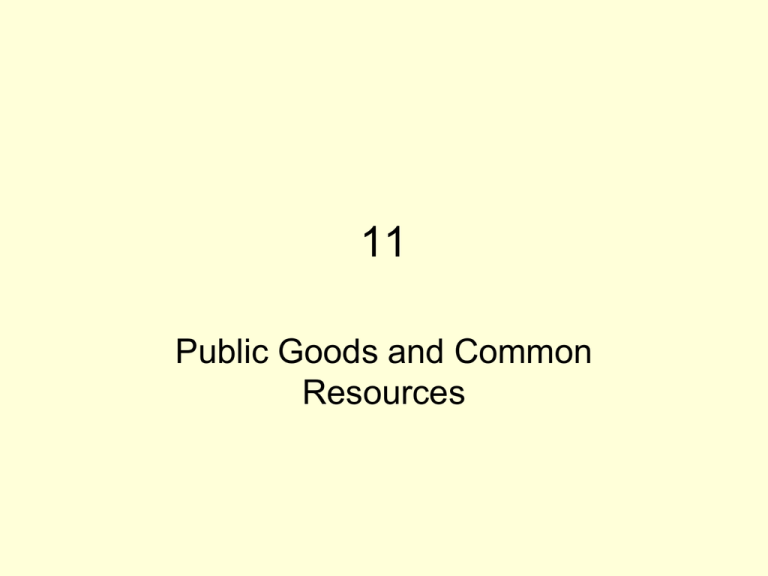
11 Public Goods and Common Resources “The best things in life are free” • Free goods provide a special challenge for economic analysis. “The best things in life are free” • When goods are available free of charge, the market forces that normally allocate resources in our economy are absent. “The best things in life are free” • When a good does not have a price attached to it, private markets cannot ensure that the socially optimum amount will be produced and consumed. – Free goods are typically under-produced and over-consumed • In such cases, government provision of such goods may raise economic well-being. THE DIFFERENT KINDS OF GOODS • When thinking about the various goods in the economy, it is useful to group them according to two characteristics: – Is the good excludable? – Is the good rival in consumption? THE DIFFERENT KINDS OF GOODS • Excludability – Consider something specific that you would like to have. Does anybody have the power or ability to stop you from using it? – If yes, the commodity is excludable, • and you will have to pay to consume it – If no, the commodity is not excludable, • and nobody can make you pay to consume it THE DIFFERENT KINDS OF GOODS • Rivalry in consumption – If you decide to enjoy or use an object, can others enjoy it too at the same time? – If no, it is a rival good – If yes, the object is a non-rival good Figure 1 Four Types of Goods Rival? Yes Yes No Private Goods Natural Monopolies • Ice-cream cones • Clothing • Congested toll roads • Fire protection • Cable TV • Uncongested toll roads Common Resources Public Goods • Fish in the ocean • The environment • Congested nontoll roads • Tornado siren • National defense • Uncongested nontoll roads Excludable? No Public Goods: The Free-Rider Problem • Since people cannot be excluded from enjoying the benefits of a public good, they may refuse to pay, hoping that others will. • That is, people may behave like free riders – A free-rider is a person who receives the benefit of a good but avoids paying for it • The free-rider problem prevents private businesses from supplying public goods. Public Goods: The Free-Rider Problem • Solving the Free-Rider Problem – The government can step forward to provide the public good • Assuming the total benefits exceed the costs. – The government can make everyone better off by providing the public good and paying for it with tax revenues. Some Important Public Goods • National Defense • Fundamental Scientific Research • Fighting Poverty Public Goods: Cost-Benefit Analysis • In order to decide whether to provide a public good or not, the total benefits of all those who use the good must be compared to the costs of providing and maintaining the public good. – Cost-benefit analysis refers to the measurement of the costs and benefits to society of providing a public good. Yes or no? • A town intersection currently has only stop signs. • Should a traffic light be installed? CHAPTER 11 PUBLIC GOODS AND COMMON RESOURCES 14 Yes or no? • In an ideal situation … – We could ask each person who uses that intersection what’s his/her willingness-to-pay for the traffic light – The traffic light should be installed if and only if the total willingness-to-pay exceeds the cost – The light could be paid for by charging a tax proportional to each person’s willingness-to-pay CHAPTER 11 PUBLIC GOODS AND COMMON RESOURCES 15 Yes or no? • However, in the real world … – Asking people won’t work – People will not reveal their willingness-to-pay truthfully • If the tax is independent of willingness-to-pay, those who would benefit/not benefit from the public good would have an incentive to exaggerate the benefits/costs • If the tax is related to willingness-to-pay people will understate their willingness to pay – So, some other kind of cost-benefit analysis will be needed CHAPTER 11 PUBLIC GOODS AND COMMON RESOURCES 16 The Difficult Job of Cost-Benefit Analysis • A cost-benefit analysis is an estimate of the total costs and benefits of the project to society as a whole. – It is difficult to do this because of the absence of prices needed to estimate social benefits and costs. – The value of life, the consumer’s time, and aesthetics are difficult to measure. How much is a life worth? • It may be necessary to know the dollar value of a human life in order to decide whether a new traffic light would be worth the cost • Studies say the dollar value of a human life is … about $10 million • Calculations: – – – – Value of lives lost without light = 0.016 × $10 m Value of lives lost with light = 0.011 × $10 m Benefit of light = 0.005 × $10 m = $50,000 Yes to traffic light if and only if cost is less CHAPTER 11 PUBLIC GOODS AND COMMON RESOURCES 18 How much is a life worth? • Isn’t it infinite? – Not if you see the risks that people take to avoid paying extra – By observing these choices economists can estimate the monetary value that people themselves place on their own lives – One estimate is $10 million CHAPTER 11 PUBLIC GOODS AND COMMON RESOURCES 19 Common Resources: non-excludable and rival Rival? Yes Yes No Private Goods Natural Monopolies • Ice-cream cones • Clothing • Congested toll roads • Fire protection • Cable TV • Uncongested toll roads Common Resources Public Goods • Fish in the ocean • The environment • Congested non-toll roads • Tornado siren • National defense • Uncongested nontoll roads Excludable? No As common resources are not excludable, they are available free of charge to anyone who wishes to use them Common resources are rival goods because one person’s use of the common resource reduces other people’s use Tragedy of the Commons • The Tragedy of the Commons is a parable that illustrates why common resources are overused – That is, they are used more than is desirable from the standpoint of society as a whole. – The idea of tragedy of the commons was popularized by the biologist Garret Hardin Tragedy of the Commons • Common resources tend to be overused because they are not excludable and so people do not have to pay to use them • Moreover, when a person uses a common resource, only that person benefits, nobody else does – Common resources are rival in consumption. – This is similar to a negative externality. – We saw in the previous chapter that negative externalities lead to over-consumption CHAPTER 11 PUBLIC GOODS AND COMMON RESOURCES 22 Tragedy of the Commons • Common resources need to be conserved for future use • However, as they are not excludable, nobody has the incentive to conserve them CHAPTER 11 PUBLIC GOODS AND COMMON RESOURCES 23 Tragedy of the Commons: solutions • The government can assert ownership of a common resource – The government can then control and restrict the use of a common resource – The government can conserve and maintain the resource for use by the people in the future • The government can assign ownership rights to private citizens – This will convert a common resource to a private resource CHAPTER 11 PUBLIC GOODS AND COMMON RESOURCES 24 Some Important Common Resources • Clean air and water • Congested roads • Fish, whales, and other wildlife A Solution to City Congestion • Motorists driving into central London on weekdays between 7:00 A.M. and 6:30 P.M. pay a daily tax of about $9.50. • Cameras record license plate numbers and nonpayers are charged stiff penalties. • Congestion in central London has decreased by 30%. • 50,000 fewer cars enter the eight square mile “restricted area” each day. CHAPTER 11 PUBLIC GOODS AND COMMON RESOURCES 26 A Solution to City Congestion: London CHAPTER 11 PUBLIC GOODS AND COMMON RESOURCES 27 A Solution to City Congestion: Singapore 28 CASE STUDY: Why Isn’t the Cow Extinct? • Will the market protect me? IN THE NEWS: Should Yellowstone Charge as Much as Disney World? • National parks can be viewed as either public goods or common resources. • If park congestion is light, visits are not rival in consumption. • As congestion increases, park entrance fees could be raised. • The likely increase in revenues… – could be used to improve national parks, and – would encourage others to develop new parks. CHAPTER 11 PUBLIC GOODS AND COMMON RESOURCES 30 CASE STUDY: “You’ve Got Spam!” • Some firms use spam email to advertise their products. • Spam is not excludable: Firms cannot be prevented from spamming. • Spam is rival: As more companies use spam, it becomes less effective. • Thus, spam is a common resource. • Like most common resources, spam is free – which is why we get so much of it! • If each person had complete ownership rights over his or her email inbox, then spammers would have to ask for permission to send spam email • You could then charge spammers a price for every spam email they send you CHAPTER 11 PUBLIC GOODS AND COMMON RESOURCES 31 CONCLUSION: THE IMPORTANCE OF PROPERTY RIGHTS • The market fails to allocate resources efficiently when property rights are not wellestablished – That is, some item of value does not have an owner with the legal authority to control it CONCLUSION: THE IMPORTANCE OF PROPERTY RIGHTS • When the absence of property rights causes a market failure, the government may be able to solve the problem. – The government can assign property rights and lay the foundation for a market where none existed before • Example: the pollution-rights market – The government can also directly regulate the private use of a common resource • Forests are protected in the US US Government Requires Fishing Permits http://www.nmfs.noaa.gov/permits.htm 34 Top-down government administration and total privatization are not the only ways to utilize and maintain a common resource. Communities of users of the resource may be able to do this more efficiently. ELINOR OSTROM 35 Elinor Ostrom: a different view • Elinor Ostrom shared the 2009 Nobel memorial prize in Economics "for her analysis of economic governance, especially the commons" – See http://nobelprize.org/nobel_pri zes/economics/laureates/2009/ index.html CHAPTER 11 PUBLIC GOODS AND COMMON RESOURCES 36 Ostrom: Tragedy of the Commons is not inevitable • Based on numerous empirical studies of usermanaged fish stocks, pastures, woods, lakes, and groundwater basins, she concluded that common property is often well tended by user associations. CHAPTER 11 PUBLIC GOODS AND COMMON RESOURCES 37 Ostrom’s seven keys to successful utilization of a common resource 1. 2. 3. 4. Rules clearly define entitlements Conflict resolution mechanisms are in place Duties stand in reasonable proportion to benefits Monitoring and sanctioning is carried out either by the users themselves or by someone who is accountable to the users 5. Sanctions are graduated, mild for a first violation and stricter as violations are repeated 6. Decision processes are democratic 7. The rights of users to self-organize are clearly recognized by outside authorities CHAPTER 11 PUBLIC GOODS AND COMMON RESOURCES 38 Ostrom: centralized control of resources can fail • All too often, resource degradation is due to flawed intervention by central government. • Consider the satellite image—next slide—of grasslands spanning two different jurisdictions. • In the southern jurisdiction, grasslands are managed by groups of nomads according to traditional methods. • In the northern jurisdiction, grasslands have been collectivized and animal husbandry has been modernized. • Despite similar numbers of grazing animals per acre, only traditional group management has prevented the grasslands from degrading and also produced greatest yields. CHAPTER 11 PUBLIC GOODS AND COMMON RESOURCES 39 Ostrom: centralized control of resources can fail • The choice is not between individual control and control by a central government • Groups of individuals can self organize and successfully form a mini government to maintain a common resource that they all use • Users themselves can both create and enforce rules that mitigate overexploitation CHAPTER 11 PUBLIC GOODS AND COMMON RESOURCES 40 Summary • Goods differ in whether they are excludable and whether they are rival. – A good is excludable if it is possible to prevent someone from using it. – A good is rival if one person’s enjoyment of the good prevents other people from enjoying the same unit of the good. Summary • Public goods are neither rival nor excludable. • Because people are not charged for their use of public goods, they have an incentive to free ride when the good is provided privately. • Governments provide public goods, making quantity decisions based upon cost-benefit analysis. Summary • Common resources are rival but not excludable. • Because people are not charged for their use of common resources, they tend to use them excessively. • Governments tend to try to limit the use of common resources.
